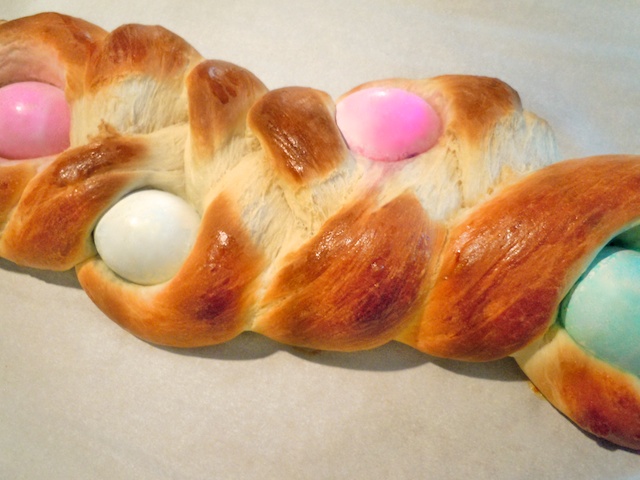 Easter has always been a favorite holiday, between the arrival and celebration of all things spring and all things rabbit, to the traditions of goody-filled baskets (our childhood Easter bunny was a rock star who gave us kites and books) and an egg-enhanced meal, what is there not to love? The weather is lovely with blooms and the mind is light and blooming, as well. And, as is once a month this year for me, the mind turns toward a bread for Easter.
Easter has always been a favorite holiday, between the arrival and celebration of all things spring and all things rabbit, to the traditions of goody-filled baskets (our childhood Easter bunny was a rock star who gave us kites and books) and an egg-enhanced meal, what is there not to love? The weather is lovely with blooms and the mind is light and blooming, as well. And, as is once a month this year for me, the mind turns toward a bread for Easter.
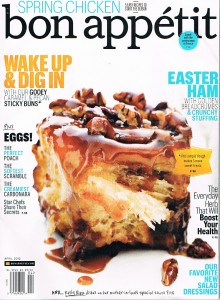 My friend Lorraine, who delights in all the sensory gifts time in the kitchen brings, knew of my monthly bread forays and recently, as we discussed springtime, mentioned an Easter bread that employed the use of real dyed eggs as decoration. I had a vague notion of seeing pictures of such a bread, and once the little picture wormed its way into my wee brain, it set up shop. I get stuck on things and must pursue them. Then, as synchronicity would have it, my issue of Bon Appetit Magazine
My friend Lorraine, who delights in all the sensory gifts time in the kitchen brings, knew of my monthly bread forays and recently, as we discussed springtime, mentioned an Easter bread that employed the use of real dyed eggs as decoration. I had a vague notion of seeing pictures of such a bread, and once the little picture wormed its way into my wee brain, it set up shop. I get stuck on things and must pursue them. Then, as synchronicity would have it, my issue of Bon Appetit Magazine
arrived and what should be contained within its luscious pages but a recipe for the magical egg bread? I needed no further nudging.
There are a number of breads associated with Easter (no surprise, given bread’s symbolism). This Easter egg bread, called “tsoureki” (TOO-reki) is a Greek tradition. A sweet Challah-like (holla!) bread dough is braided, and dyed Easter eggs are tucked within. Upon further reading, I discovered the Greeks often used eggs dyed red to symbolize the blood of Christ. For practical purposes, the average baker will use eggs imparted with a fairer coloring, as the dye can stain the bread.
Bon Appetit’s recipe employs a “Master Sweet Dough,” from which this and a number of delightful-looking breads and rolls are created (to see all of the creations, click here . You do not have to be a master baker to create the master dough, the magazine encourages, so it was with delightful anticipate and a handful of freshly dyed pastel Easter eggs that I approached this bread-baking project. Making a braided bread has long been on my bucket list…let’s say Easter bucket list!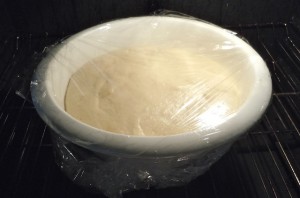
The dough was easy and puffed up loftily upon its first raising. Next, I divided the dough into three equal (well, AWS always has a little trouble with proportions), or close to equal pieces and fashioned three dough ropes, about 16 inches in length.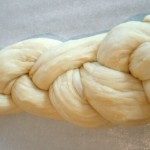
Now to braid…suddenly, as I stared at the dough ropes, I completely drew a blank. I had been braiding my own hair since I was a child, but at this moment, I forgot how to do it! Something tactile seized me, and it all came back. Whew! The braid was lovely, and there was something satisfying and motherly in nestling those eggs (I used four) between the braids of that warm, buttery dough.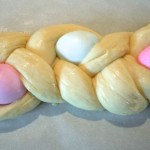
The braid baked up a beautiful honey brown, filling the house with that incomparable aroma…nothing like fresh bread. The colorful eggs took on a sheen. And the bread, tender, buttery and moist, but not too sweet, was light, flavorful and satisfying. I was curious about the twice-cooked eggs. Some suggested that, having been boiled and baked, they would be inedible…we did not find them so. Like those memories of Easters past, each egg, along with each slice of bread, would be relished with appreciation.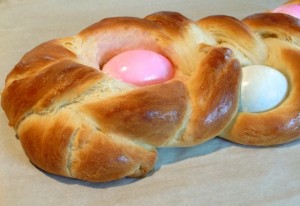
Easter Bread
From Bon Appetit magazine
Ingredients
6–7 large eggs
Food coloring (optional)
Master Sweet Dough (see recipe below)
All-purpose flour (for dusting)
Place 5 or 6 eggs in a medium pot. Pour in cold water to cover by 1 inch and bring to a boil over
medium-high heat. Remove from heat, cover pot, and let stand for 10 minutes. Transfer eggs to a
medium bowl of ice water; let cool completely. If desired, color eggs according to food-coloring
package directions. Transfer eggs to paper towels to dry. DO AHEAD: Eggs can be dyed up to 1
week ahead. Cover and chill.
Line a large baking sheet with parchment paper. Punch down dough. Divide into 3 equal pieces.
With lightly floured hands, roll each piece on a lightly floured surface into a 16-inch-long rope with
tapered ends. (If dough begins to bounce back, cover with a kitchen towel and let rest for 10
minutes to allow dough to relax.)
Arrange ropes side by side lengthwise on prepared sheet. Pinch top ends together. Braid dough.
Pinch bottom ends together to secure (braided loaf will be about 12 inches long). Tuck dyed eggs
between braids, spacing evenly. Loosely cover with plastic wrap or a kitchen towel. Let rise in a
warm, draft-free area until puffed but not doubled in size, 45–50 minutes.
Arrange a rack in middle of oven; preheat to 375°. Whisk remaining egg with 2 tsp. warm water in a
small bowl. Avoiding dyed eggs, brush dough all over with egg wash. Bake until bread is golden
and an instant-read thermometer inserted into center of loaf registers 190°, 20–25 minutes. Let cool
on a wire rack. Serve warm or at room temperature. DO AHEAD: Can be made 8 hours ahead. Let
cool completely and store airtight at room temperature.
Master Sweet Dough
From Bon Appetit magazine
Ingredients
2/3 cup whole milk
5 tablespoons sugar, divided
1 3/4 teaspoons active dry yeast (from one 1/4-ounce envelope)
2 large eggs, room temperature
2 3/4 cups unbleached all-purpose flour
1 teaspoon kosher salt
1/2 cup (1 stick) unsalted butter, cut into 1-inch pieces, room temperature, plus
1/2 tablespoon,melted
Heat milk in a small saucepan over medium heat or in a microwave until an instant-read thermometer registers 110°–115°. Transfer milk to a 2-cup measuring cup; stir in 1 Tbsp. sugar. Sprinkle yeast over milk and whisk to blend. Let sit until yeast is foamy, about 5 minutes. Add eggs; whisk until smooth.
Combine remaining 4 Tbsp. sugar, flour, and salt in the bowl of a stand mixer fitted with a dough hook. Add milk mixture. With mixer running, add 1/2 cup room-temperature butter, 1 piece at a time, blending well between additions. Mix on medium speed for 1 minute. Knead on medium-high speed until dough is soft and silky, about 5 minutes.
Brush a medium bowl with some melted butter; place dough in bowl. Brush top of dough with remaining melted butter; cover with plastic wrap. DO AHEAD: Can be made 1 day ahead. Cover with plastic; chill.
Let dough rise in a warm, draft-free area until doubled in size, 1–1 1/2 hours (or 2–2 1/2 hours if dough has been refrigerated).